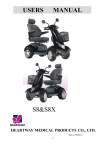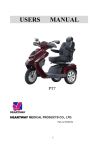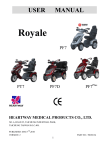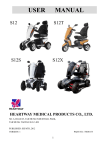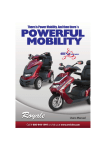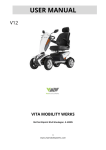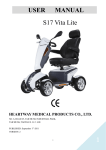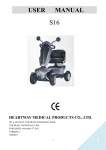Download Venus S9
Transcript
USERS MANUAL S9 HEARTWAY MEDICAL PRODUCTS CO., LTD. Part no:70030170 1 CONTENTS 1. Techni cal S peci fi cat i on ……………. ...................... .......... .......... …………… . 3 2. S a f et y In s t r u c t i o n … … …… … …… ……… … …… … …… … . … … …… … …… .. 4 ~ 6 3. Environment Condition …………………………………………….………………....7 4. Wa r r a n t y … … … … … … … … … … … … … … … … … … … … … … … . . … … … … … . . 8 5. A s s e m b l y I n s t r u c t i o n … … … … … … … … … … … … … … … … . … … … … … . . 9 6. Adjustment For Seating Comfort………………….…………………………….……..11 7. Control Panel Layout……………………………….…………………………….…..12 8. F u n c t i o n s … . . … … … … … … … … … … . … … … … … … … … … … … … … … . . … 1 3 8 -1 . Fun ct i o n De sc ri pt i o n …… ……… … ………… …… .. ... ... .. ..... ... ... .... ... ... 1 3 8-2. Buttons & Indicators ……………………………………………… .……..14 9. Us a ge C ondi t i ons … ……… .. …….… …… ………………………… ……… ………1 4 10. C h a r a c t e r i s t i c s … … … … . . … … … … … … … … … … … … … … … … … … … … … 1 5 11. Operation of Control Panel………………………………………………………………15 11 -1. Tem p e r at u re Met e r …… ……… … ………… …… . .. ... ... . .... ... .. ... ... ... ... 1 5 11 -2 . C l ock…………………… …………………………… .……………… .…… ..1 6 11 - 3 . O d o m e t e r … … … … … … … … … … … … … … … … … . . … … … … … … … . . 1 7 11 - 4 . S p e e d o m e t e r … … … … … … … . . … … … . … . . … … … … … … … … … … … . 1 9 11 -5 . Hi gh/ Lo w S p e ed & Tu rn Ind i c at or ……… …… ……… … …… ……… . 21 11 -6. P ower Indi ca t i on ………………………………………………………… . . . 22 11-7. Headli ght & Position Li ght …………………..……….………………….24 11-8. Brake and Reversing Light………………….………………………………….25 11-9. Direction Indicators ……………………………………………………… ...26 11-10. Malfunction Messages ……………………..……………………………….27 11 -11. P ower-On-S el f-Test…………………… ..……………………………… ... 28 12. Maintenance and Repair………………………………………………………………29 13. System Configuration & BOM List....……………………………………………………32 2 TECHNICAL SPECIFICATIONS 3 SAFETY INSTRUCTION OPERATION OF SCOOTER 1. 2. To prevent injury to yourself or others, always ensure that the power is switched off when getting on or off of the scooter. Always check that the drive wheels are engaged (drive mode) before driving. Engage Free Wheel (Fig.1) 3. Do not switch off the power when the scooter is still moving forward. This will bring the chair to an extremely abrupt stop. Power Off Power On (Fig.2) (Fig.3) 4 4. Emergency Brake (Optional) General 1. 2. 3. Always use a seat belt, and keep your feet on the scooter all the time. Do not over load the scooter with it’s maximum weight capacity of 135kg (300 lbs) Do not attempt to lift or move a power scooter by any of its removable parts. Personal injury and damage to the power chair may result. 4. 5. 6. Never try to use your scooter beyond its limitations as described in this manual. Do not operate your vehicle if it is not functioning properly. Do not connect any electrical or mechanical device to the scooter. Failure to obey this instruction may result in injury and will void the warranty. Never use electronic radio transmitters such as CB, walkie-talkies, portable computers or cellular phones while using the vehicle without first turning the scooter off. 7. Usage When Under The Influence Of Medication Or Alcohol 1. Check with your physician if you are taking any medication that may affect your ability to operate your power scooter safely. 2. Do not operate your scooter while you are under the influence of alcohol, as this may impair your ability to operate your power scooter in a safe manner. Electromagnetic interference (EMI) from Radio Wave Sources The rapid development of electronics, especially in the area of communications, has saturated our environment with electromagnetic (EM) radio waves that are emitted by television, radio and communication signals. These EM wave are invisible and their strength increases as one approach the source. All electrical conductors act as antennas to the EM signals and, to varying degrees, all power wheelchairs and scooters are susceptible to electromagnetic interference (EMI). The 5 interference could result in abnormal, unintentional movement and/or erratic control of the vehicle. The United States Food and drug Administration (FDA) suggests that the following statement be incorporated to the user’s manual for all power scooter like the S9. Power wheelchairs and motorized scooters (in this section, both will be referred to as powered wheelchairs) may as susceptible to electromagnetic interference (EMI), which is interfering electromagnetic energy emitted from sources such as radio stations, TV stations, amateur radio (HAN) transmitter, two-way radios and cellular phones. The interference (from radio wave sources) can cause the powered wheelchair to release its brakes, move by itself or move in unintended directions. It can also permanently damage the powered scooter’s control system. The intensity of the EM energy can be measured in volts per meter (V/m).Each powered scooter can resist EMI up to a certain intensity. This is called “immunity level”. The higher the immunity level the greater the protection. At this time, current technology is capable of providing at least 20 V/m of immunity level, which would provide useful protection against common sources of radiated EMI. Following the warnings listed below should reduce the chance of unintended brake release or powered scooter movement that could result in serious injury: 1. 2. 3. 4. 5. Do not turn on hand-held personal communication devices such as citizens band (CB) radios and cellular phones while the powered scooter is turned on. Be aware of nearby transmitters such as radio or TV stations and try to avoid coming close to them. If unintended movement or brake release occurs, turn the powered scooter off as soon as it is safe. Be aware that adding accessories or components, or modifying the powered scooter, may make it more susceptible to interference from radio wave sources (Note: It is difficult to evaluate the effect on the overall immunity of the powered scooter). Report all incidents of unintended movement or brake release to the powered scooter manufacturer, and note whether there is a radio wave source nearby. TURN OFF YOUR POWERED SCOOTER AS SOON AS POSSIBLE WHEN EXPERIENCING THE FOLLOWING: ‧ Unintentional scooter movements ‧ Unintended or uncontrollable direction. ‧ Unexpected brake release The FDA has written to the manufacturers of power scooters asking them to test new products to be sure they provide a reasonable degree of immunity against EMI. The FDA requires that a powered wheelchair should have an immunity level at least 20 V/m, which provides a reasonable degree of protection against more common sources of EMI. The higher the immunity level, the greater the protection. Your powered scooter has an immunity level of 20 V/m which should protect against common sources of EMI. 6 ENVIRONMENTAL CONDITIONS Environmental conditions may affect the safety and performance of your power scooter. Water and extreme temperatures are the main elements that can cause damage and affect performance. A) Rain, Sleet and Snow If exposed to water, your power scooter is susceptible to damage to electronic or mechanical components. Water can cause electronic malfunction or promote premature corrosion of electrical components and frame. B) Temperature Some of the parts of the power scooter are susceptible to change in temperature. The controller can only operate in temperature that ranges between 18℉(-8℃) and 122℉ (50℃). At extreme low temperatures, the batteries may freeze, and your power scooter may not be able to operate. In extreme high temperatures, it may operate at slower speeds due to a safety feature of the controller that prevents damage to the motors and other electrical components. 7 WARRANTY Quality/ Warranty Declaration Products are to be fit for purpose and of excellent quality and performance. For valid warranty claims Heartway will, at their discretion, replace/ repair/ refund items mutually agreed to be defective. Heartway’s warranty as following: (1) Frame: two year limited warranty (2) Electronic Components and Charger: one year limited warranty. (3) Controllers: one and half year limited warranty (4) Batteries: not warranted. (5) Consumables (wheel tires, arm pads, and seat cushions): not warranted. Any damage or defect of any nature occurring from the misuse of the product is not to be covered. The warranty is to start from the date of arrival of our products. 8 ASSEMBLY INSTRUCTION It is very easy to assemble your S9 scooter. Please follow the procedure below. 1. Tiller Positioning Press down the lever, fold the tiller up to vertical position and let it lock into your preferred position. (See Fig 4 & 5) (Fig.4) (Fig.5) 2. Installing the Seat (Fig.6) 9 3. Installing the Batteries Remove three screws as shown on Fig.7 and take off the cover. Connect both battery cables probably (﹢/ ﹣pole ,Red is positive, black is negative) Connected (Fig.7) (Fig.8) ADJUSTMENTS FOR SEATING COMFORT A. Armrest Position Adjustment Turn the round plate and adjust to your position. Anticlockwise will move the armrest upward and clockwise will be downward (Fig.9) 10 B. Seat Rotation and Position Adjustment B-1: Seat Rotation Adjustment → Press the seat swivel lever downward. → Rotate your seat by clockwise or counter-clockwise direction. (Fig.10) (Fig.11) B-2: Seat Position Adjustment → Push the seat adjust lever upwards. → slide your seat backward or forward to your desired position → let the lever lock into your preferred position.(See Fig 12) Note: The distance of adjustment from backward to forward is 150mm. (Fig 12) 11 OPERATION AND CONTROL PANEL 1. Control Panel Layout LCD(Liquid Crystal Display)Power Scooter Control Panel, TN Type LCD Screen LED LED Indications Indications Right Indicator Left Indicator Headlight Position Light Parking Indicator Warning Indicator Left Indicator control Right Indicator control SET button Parking lamp control Position Light control MODE button High / Low speed control Headlight control Horn Button Function & Adjustment Buttons 12 2. Functions 2-1 Function Descriptions SPECIFICATION FUNCTION 1 Temperature “C” / “F” modes 2 Clock Hour / Minute display and setting 3 Odometer Trip Meter ODO (99999 max), TRIP (999.9 max) Sum of distance and time 4 Speedometer 7 Segment display (2 1/2 digits +1 decimal) “km/h” and “mph” symbol 5 High /Low Speed & Turn Status Indicated as icon and 6 Power Indicator Battery remaining capacity and charging indicator (6 squares + Battery icon) 7 Headlight Blue LED Including “Power-Saving” mode 8 Position Light Orange LED Placed inside headlight, used while rainy or gloomy weather 9 Brake Light Including “Brake-Mode” and “Parking Mode” 10 Left-Right Direction Indicators Green LED Flash mode Auto switch-off after 30 seconds Parking Light Red LED Including “Parking Mode” Right/Left indicators flash simultaneously 11 12 Malfunction Messages Red LED Malfunction code: 7 Segment display (1digit) + warning symbol 13 Power-On-Self-Test All LED illuminated 13 2-2 Buttons & Indicators ITEM DESCRIPTION Function & Adjustment Buttons: Left-Indicator (Green) Right- Indicator (Green) Position Light (Amber) Headlight (Blue) Warning Indicator (Red) Parking Indicator (Red) LED Indicators LCD Backlight Connecter Illumination: 700 mcd min (Orange color) CON1: 20PIN 3. Usage Conditions ITEM Voltage SPECIFICATION DC 24 V Operation Voltage DC 16 ~32 V Storage Temperature -40C ~ 90C Operation Temperature -25C ~ 55C Meter Angle at Handle Cover 30 of elevation while scooter assembly (LCD orientate to 6 o’clock) 14 4. Characteristics Test General Characteristic Performance Test (20 5℃) Hardware Circuit: ITEM SPECIFICATION Lowest Operation Voltage 16V max RESULT (n = ) V Dynamic: 200 mA max (backlight and all of LED illuminated) Consuming Current (VB = 24.0V) MA mA Static: 5 mA max (Key Off status) 5. Operation of Control Panel 5-1. Temperature Meter ITEM DESCRIPTIONS Operation Feature Temperature sensor (NTC) detects and transfers the signal to a temperature value. Tolerance 2C Press to switch to TEMP-Mode: Working Mode * Display Range : -20C ~50C 15 / -4F ~122F ITEM Setting Mode (Unit Switch) DESCRIPTIONS Press + for more than 2 seconds to enter Setting-Mode, and the backlight illuminates in the meantime. When “C” or “F” flashing, press to switch C / F. Under Setting-Mode, when 1) idle for more than 20 seconds, Exit Setting Mode 2) press + for more than 2 seconds, the system will save the last setting value automatically and back to Working-Mode. 5-2. Clock ITEM Tolerance Initial Setting Value DESCRIPTIONS ±2 sec. (per day) 『Hour:Min』mode :『AM 12:00』 Press to switch to CLOCK-Mode: AM PM Working Mode Display Range : AM12:00 ~ PM11:59 During 1 to 9 o’clock, “0” of tens on Hour digits won’t show on LCD. 16 ITEM DESCRIPTIONS Press + for longer than 2 seconds to enter Setting-Mode, the backlight illuminates in the meantime. 1) When “Hour” digit is flashing, press then press Setting Mode (Time Switch) into “Min” setting mode. 2) When “Min” digit is flashing, press press If press to increase the number, and to increase the number, then back to “Hour” setting mode. for longer than 2 seconds, the number will increase continually till the button released. The setting value runs cyclically ( only 2 sec. from 0 to 9) Under Setting-Mode, when 1) idle for longer than 20 seconds Exit Setting Mode 2) press + for longer than 2 seconds, the system will save the last setting value automatically and back to Working-Mode. 5-3. Odometer ITEM Operation Features DESCRIPTIONS OptoCoupler sensor detects the signal and then converts into a distance value. When speedometer was set as 「km/h」, the odometer displays as kilometer. Units Switch 「mph」, the odometer displays as mile. 「/h」, means the odometer is displaying as travel hours. 17 ITEM DESCRIPTIONS Press switching to『ODO』mode mph km/h ODO Mode Display Range:00000~99999 When the total distance ran to 99999km or 62149mile (99999÷1.609mile), the digits will be reset to zero “00000”. Press switching to『TRIP』mode TRIP Mode Display Range:0.0~999.9 When the distance goes to 999.9, the counter will stop, please press for 3 seconds to reset to zero “0.0”. 18 5-4. Speedometer ITEM Operation Features DESCRIPTIONS OptoCoupler sensor detects the signal and then converts into a speed value. When drive shaft runs at 2100 rpm, speedometer will display “60km/h”. Tolerance +15~20% Digits range 0.0 ~ 30.0 Setting Mode (Units Switch) Display Rate:0.5 Press + for longer than 2 seconds to enter Setting-Mode, backlight illuminates in the meantime. When 『km/h』 / 『mph』/ 『/h』are flashing, press the unit. 19 to switch ITEM DESCRIPTIONS to enter 『SPEED』mode Press mph km/h 「km/h」means the speed is counted as kilometer. 「mph」means the speed is counted as mile. When SPEED was set on “km/h” or “mph”, even the waiting screen is not SPEED mode, LCD will switch to SPEED mode when WIP (accelerator) is Working Mode acting, and back to previous waiting screen automatically once WIP (accelerator) stopped. When SPEED was set on “/h”, speedometer will be disabled (fit to non-speedometer model) and replaced by WIP (accelerator) operation screen. Forward Backward When SPEED was set on “/h”, LCD won’t switch automatically to SPEED mode from another screen while WIP acted. Under setting mode, when 1) idle for 20 seconds Exit Setting Mode 2) press + for longer than 2 seconds, the system will save the last setting value automatically and back to Working-Mode. 20 5-5. High/Low Speed & Turn Indicators ITEM DESCRIPTIONS Operation Features Press to switch High / Low speed. (*Control signals: TRN, with memory storage) Take exterior turn-switch as determinant signal (*Control signals: TRN) High Speed: Symbols of Status Low Speed: Turn Status: Flicker Frequency (Flashing) 1 second 21 5-6. Power Indication ITEM DESCRIPTIONS Remaining Scale Bar Capacity (%) 100 (6) 85 (5) 70 (4) Battery Remaining 55 Capacity (3) 40 (2) 30 (1) and icon is flashing 20 Warning LED Flicker Frequency Operation Characters is flashing 2 seconds The scale status only decrease, won’t increase. When the remaining capacity was less than 30%, warning sound (“Bi-Bi” - two short sounds) act at 1 second intervals. While (1) Key OFF (2) Charging-Mode (3) Sleep-Mode, the warning sound will be released. 22 ITEM DESCRIPTIONS Remaining Capacity (%) Scale Bar 40 (2) 55 (3) 70 (4) Charge Indication 80 (5) 90 (6) 100 (7) Increase Frequency Operation Character Remarks 0.5 second Scale status only decrease, won’t increase. Take the PIN3(CH3) of charger as the determinant signal, when CH3 is grounded (L), LCD will enter Charging-Mode, not limited by “KEY ON” or “KEY OFF”. Any pressing of button will illuminate LCD backlight, and switch off automatically if no more pressing after 5 seconds. Above scale bar status only for reference, the accurate diagnosis is still subject to the indicator of charger. 23 5-7. Headlight ITEM DESCRIPTIONS Take exterior headlight switch as determinant signal. Operation Feature Power Saving Mode Usage Condition Determinant Condition Remarks Press button to switch on/off LED . LCD backlights will be turned on/off when headlight switching on/off. When motor is resting, power modulate down to 30% (Headlight) When motor acts, power modulate up to 100% (Headlight) While (1) KEY OFF (2) Power-Saving Mode (3) Sleep-Mode, the function will be disabled. Power-Saving Full-Power : React immediately Full-Power Power-Saving : 5 sec delay (1) Loop Load: 24V/50W max (2) With “short circuit” and “overload” protection 5-8. Position Light ITEM DESCRIPTIONS Take exterior position-light switch as determinant signal. Operation Feature Usage Condition Remarks Press button to switch on/off LED . LCD backlights will be turned on/off when back-up lamp switching on/off. While (1) KEY OFF (2) Power-Saving Mode (3) Sleep-Mode , the function will be disabled. (1) Loop Load: 24V/50W max (2) With “short circuit” and “overload” protection 24 5-9. Brake and Reversing Light ITEM Operation Feature DESCRIPTIONS Take exterior WIP / RBK / Headlight / Back-up lamps switch as determinant signal. Control Mode Usage Condition Determinant Condition Remarks Flicker Frequency Judge to be “Brake” or “Handbrake” state, when WIP (accelerator) signal changed from actuated to neural position, and will recover automatically after 3 seconds (Brake-Light Mode). Judge to be “Reverse” state, the brake light flashes (Reversing-light Mode) When the headlight and position light was turned on/off, and the brake light will be turn on/off simultaneously. While (1) controller closed (2) Charging-Mode, the function will be disabled. Parking status is adjusted by “motor direction” and “controller” Warning sound of parking was managed by controller (1) Loop Load: 24V/50W max (2) With “short circuit” and “overload” protection (electric type) 1 second 25 5-10. Direction Indicators and Parking Light ITEM Operation DESCRIPTIONS Take exterior left-right direction indicators and parking lamp switch as the determinant signal. Feature (Control Mode) Left-direction lamp Press button once, the left-indicator start to flash, and the warning sound act simultaneously, then press button again to switch off the indicator. Right-direction lamp Press button once, the right-indicator start to flash, and the warning sound act simultaneously, then press button again to switch off the indicator. Parking lamp Press button once, the right /left/ park indicators start to flash, warning sound act, then press button again to turn off above indicators. Usage Condition Flicker Frequency Warning Sound Frequency While (1) KEY OFF (2) Charging-Mode (3) Sleep-Mode, the function will be disabled. 1 second One short “Bi” sound per second Left-Right indicators have priority to Parking lamp. <Ex.> Determinant Condition Remarks If “Parking lamp” turned on already, now you start “Right indicator” function, the flashing indicator lamps will change from both side (left & right) to right side, and the “Parking lamp” function will be closed. (1) Load circuit for left-direction light: 24V/50W max (2) Load circuit for right-direction light: 24V/50W max (3) With “short circuit” and “overload” protection 26 5-11. Malfunction Messages ITEM Operation Feature DESCRIPTIONS Take the connector pin (KEY) of controller as determinant signal, then converts it into digital code. When the controller send out an error message, warning indicator start flashing with controller signal at same time, the “Error message code” will show on LCD screen. Usage Condition Flicker Frequency 1 second Controller message (Flicker) Message code symbol 1 2 3 4 5 6 7 8 9 -2 3 4 5 6 7 8 9 -On On On On On On On On Status Battery needs charge soon. Low-voltage, needs charge now Over-voltage Over-current Park Brake lost or faulted Accelerator not align center Accelerator broken or faulted Motor broken or faulted Others 27 5-12. Power-On-Self-Test ITEM DESCRIPTIONS Initial Status When scooter power on, the control panel will take a self-test first; the backlight and all LCD segments will be tuned on for 3 seconds, then switch automatically to the default working mode. LCD Backlight When press + buttons, the LCD backlight will illuminate and turn off automatically if the button doesn’t be operated for longer than 5 seconds. 28 6. MAINTENANCE & REPAIR Your power scooter is designed for minimal maintenance. However, like any motorized vehicle it requires routine maintenance. To keep your S9 for years of trouble-free operation, we recommend you follow the following maintenance checks as scheduled. DAILY CHECKS 1. Visual check on the conditions of tyres. 2. Inspect the battery condition meter on the controller to determine if batteries need to be charged. WEEKLY CHECKS 1. Your power scooter comes with standard pneumatic tyres. If your power scooter comes with optional air tires, make sure to maintain the pressure of the tires between 30-35 psi. MONTHLY CHECKS 1. Visually inspect the controller harnesses. Make sure that they are not frayed, cut or have any exposed wires. SEMI-ANNUAL CHECKS 1. Check the motor brushes. We recommended that your authorized dealer inspect the brushes every six months or sooner if your power scooter is not operating smoothly. If inspection determines excessive wear on the brushes, they must be replaced or motor damage will result. Warning! Failure to maintain the brushes could void the power scooter warranty. To inspect or replace the motor brushes: Unscrew the motor brush caps. Remove the brushes. Less than 9 mm Inspect the brushes for wear. Replace the brushes if necessary. New Motor Brush Worn Motor Brush Motor Brush caps Inspect the state of the battery terminals every six months. Make sure that they are not corroded and the connections are tight. Periodically apply a thin film of petroleum jelly on the surface of terminals to guard against corrosion. 29 CHECKS Number Make sure to keep the controller clean while protecting it from rain or water. Never hose off your power scooter or place it in direct contact with water. Keep wheels free from lint, hair, sand and carpet fibers. Visually inspect the tire tread. If less than 1mm(1/32”), please have your tyres replaced by your local dealer. All upholstery can be washed with warm water and mild soap. Occasionally check the seat and back for sagging, cuts and tears. Replace if necessary. Do not store your scooter in damp or humid conditions as this will lead to mildew and rapid deterioration of the upholstery parts. All moving mechanism will benefit from simple lubrication and inspection. Lubricate using petroleum jelly or light oil. Do not use too much oil, otherwise small drips could stain and damage carpets and furnishings etc. Always perform a general inspection of the tightness of all nuts and bolts. RHINO controller: Your scooter is fitted with a Rhino controller, which continuously monitors the operating conditions of your scooter. If it detects a problem it will indicate with error message by flashing light on the power ON/ OFF light. You must count the number of the flash, and see the list to check what kind of error has happened according to the number) of Fault Impact Flashes 1 on Notes Scooter Battery needs Will drive Battery charge is running low. Recharge the batteries as recharging 2 soon as possible. Battery voltage Drive inhibited Battery charge is empty. Recharge the batteries. If the too low scooter is left off for a few minutes, battery charge may recover sufficiently to allow driving for a short period of time. 3 Battery voltage Drive inhibited Battery charge is too high. If a charger is plugged in, too high unplug it or turn the Charge/Run switch to Run. Scooters powered by RHINO will charge the batteries when traveling down slopes or decelerating. Excessive charging in this manner may cause this fault. Turn the scooter power off and then back on again. 4 Current limit Drive inhibited The scooter has drawn too much current for too long, time out possibly because the motor has been over worked, jammed or stalled. Turn the scooter power off, leave for a few minutes, and then turn the power back on again. The controller has detected a shorted motor. Check the 30 loom for shorts and check the motor. Contact your service agent. 5 Brake fault Drive inhibited Check that the park brake release lever is in the engaged position . The park brake coil or wiring is faulty. Check the park brake and wiring for open or short circuits. Contact your service agent. 6 Out of Neutral Drive inhibited Throttle is not in neutral position when tuning switch key at Power Up on. Return throttle to neutral, turn power off and back on again. Throttle may need to be re-calibrated Check throttle wiring. 7 Speed Pot Drive inhibited The throttle or its wiring is faulty. Check for open or Error short circuits. Throttle may not be correctly set up. Contact your service agent. 8 Motor Volts Drive inhibited The motor or its wiring is faulty. Check for open or short Error circuits. Contact your service agent. 9 Other Internal Drive inhibited Contact your service agent. Errors Note: If you experience any technical problems, it is recommended that you check with your local dealer before attempting to troubleshoot on your own. The following symptoms could indicate a serious problem with your power scooter. Contact your local dealer if any of the following arises: 1. Motor noise 2. 3. 4. 5. 6. 7. 8. 9. Frayed harnesses Cracked or broken connectors Uneven wear on any of tires Jerky motion Pulling to one side Bent or broken wheel assemblies Does not power up Powers up, but does not move 31 7. System Configuration ITEM SPECIFICATION Controller RHINO Series Wig-Wag CTE NCW-K001 Bulbs 24V / 50W max 7. Circuit Diagram 32 33

































